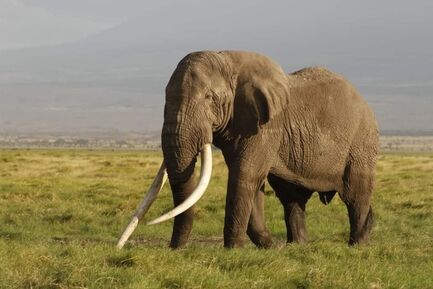
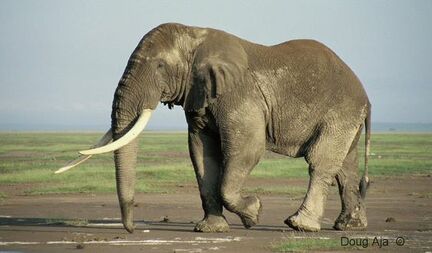
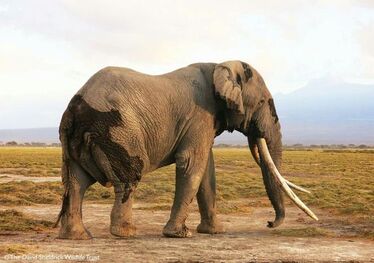
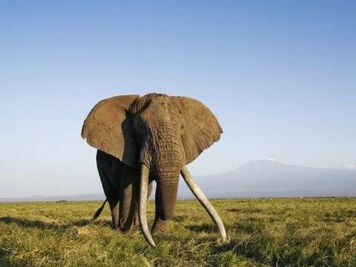
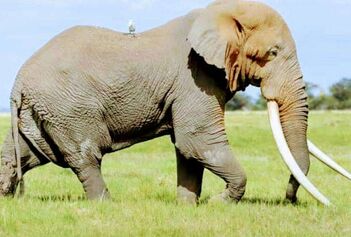
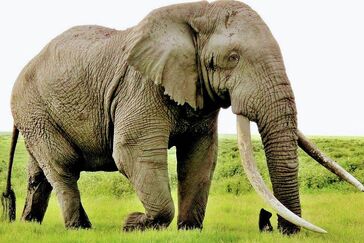

The African bush elephant (Loxodonta africana), also called the African savanna elephant is one of the only 2 living elephants of the genus Loxodonta.
Biology[]
Skin and ears[]
The African bush elephant has grey skin with scanty hairs. Its large ears cover the whole shoulder, and can grow as large as 2 m × 1.5 m (6.6 ft × 4.9 ft). Large ears help to reduce body heat; flapping them creates air currents and exposes large blood vessels on the inner sides to increase heat loss during hot weather. The African bush elephant's ears are pointed and triangular shaped. Its occipital plane slopes forward. Its back is shaped markedly concave. Its sturdy tusks are curved out and point forward.
Size[]
The African bush elephant is the largest and heaviest land animal on Earth, with a maximum recorded shoulder height of an adult bull of 3.96 m (13.0 ft) and an estimated weight of up to 10.4 t (11.5 short tons). On average, males are about 3.20 m (10.5 ft) tall at the shoulder and weigh 6.0 t (6.6 short tons), while females are much smaller at about 2.60 m (8.53 ft) tall at the shoulder and 3.0 t (3.3 short tons) in weight. Elephants attain their maximum stature when they complete the fusion of long-bone epiphyses, occurring in males around the age of 40 and females around the age of 25.
Trunk[]
The trunk is a prehensile elongation of the upper lip and nose. Short tactile hair grows on the trunk, which has two finger-like processes on the tip. This highly sensitive organ is innervated primarily by the trigeminal nerve, and thought to be manipulated by about 40,000–60,000 muscles. Because of this muscular structure, the trunk is so strong that elephants can use it for lifting about 3% of their own body weight. They use it for smelling, touching, feeding, drinking, dusting, sound production, loading, defending, and attacking. Functional loss of the trunk due to floppy trunk syndrome sometimes forces elephants to carry their trunks over their tusks and walk into deep water in order to drink. A 2021 study found that African elephants can also use their trunks to suction up food, capable of inhaling "at speeds exceeding 490 feet per second, or almost 30 times as fast as humans can sneeze."
Tusks[]
Both sexes have tusks, which erupt when they are 1–3 years old and grow throughout life. Tusks grow from deciduous teeth known as tushes that develop in the upper jaw and consist of a crown, root and pulpal cavity, which are completely formed soon after birth. Tushes reach a length of 5 cm (2 in). They are composed of dentin and coated with a thin layer of cementum. Their tips bear a conical layer of enamel that is usually worn off when the elephant is five years old. Tusks of bulls grow faster than tusks of females. Mean weight of tusks at the age of 60 years is 109 kg (240 lb) in bulls, and 17.7 kg (39.0 lb) in cows. The longest known tusk of an African bush elephant measured 3.51 m (11.5 ft) and weighed 117 kg (258 lb).
Molars[]
The dental formula of the African bush elephant is 1.0.3.3/0.0.3.3 × 2 = 26. It develops six molars in each jaw quadrant that erupt at different ages and differ in size. The first molars grow to a size of 2 cm (0.79 in) wide by 4 cm (1.6 in) long, are worn by the age of one year and lost by the age of about 2.5 years. The second molars start protruding at the age of about six months, grow to a size of 4 cm (1.6 in) wide by 7 cm (2.8 in) long and are lost by the age of 6–7 years. The third molars protrude at the age of about one year, grow to a size of 5.2 cm (2.0 in) wide by 14 cm (5.5 in) long and are lost by the age of 8–10 years. The fourth molars show by the age of 6–7 years, grow to a size of 6.8 cm (2.7 in) wide by 17.5 cm (6.9 in) long and are lost by the age of 22–23 years. The dental alveoli of the fifth molars are visible by the age of 10–11 years. They grow to a size of 8.5 cm (3.3 in) wide by 22 cm (8.7 in) long and are worn by the age of 45–48 years. The dental alveoli of the last molars are visible by the age of 26–28 years. They grow to a size of 9.4 cm (3.7 in) wide by 31 cm (1.0 ft) long and are well worn by the age of 65 years.
Legs[]
The legs of an African bush elephant are very tall, African bush elephants, African Forest elephants and Asian elephants all have five toenails on the front and five toenails on the rear. The biggest toenail of an elephant is surprisingly the first toenail and the smallest toenail is the fifth toenail. People say that elephants probably have a “sixth” toe, however it is proved that the “6th” toe basically was an enlarged bone that looked like it had a sixth toe. This proves elephants do not have polydactyl.
